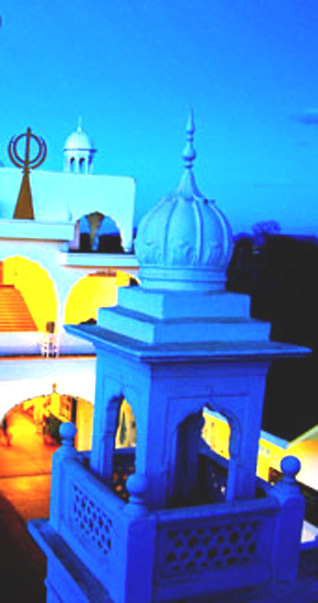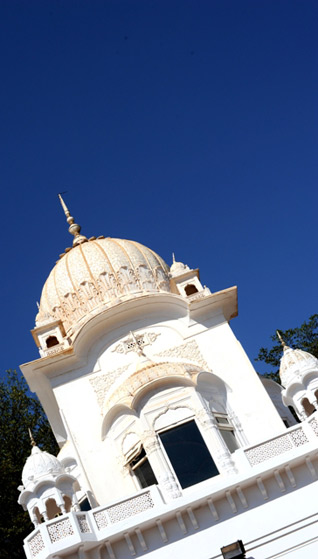Travel
A Spiritual Safari:
The Fabled Makindu Gurdwara of Kenya
SUSAN WONG
Some travelers swear by road trips. Others shudder at the thought. And with unpredictable traffic delays on Kenyan roads, driving anywhere from five to eight hours from Nairobi to Mombasa is usually meant for only the patient and intrepid types.
Hot, irritable and mentally fatigued from being hyper-attentive, avoiding risky motorists that seem to only overtake at the worst places along the road; it seems that only a hot smooth cup of chai and some delicious wholesome food can calm your spirits.
And what better way to calm your spirits than paying a visit to the Gurdwara in Makindu?
Just off the main road, the Makindu Gurudwara, a place of worship for Sikhs, which can be identified from a distance by tall flagpoles bearing the Sikh flag, is a must-visit for weary travelers.
Once past the gate, leaving the dusty, chaotic and overcrowded road behind; colourful peacocks and clean, tranquil and pristine lush grounds greet you, reminding you that paradise is always just around the corner.
Upholding to the philosophies of Sikhism, free food and shelter is provided to anyone who passes through the gates of the gurdwara – regardless of religion, caste, colour, creed, age, gender or social status. Promoting ethics of sharing, community, inclusiveness, and oneness of all humankind, the langar hall is a canteen where volunteers from the community prepare delicious vegetarian food.
Accommodation is also available for travelers up to two nights. There are no charges for these services, but since the gurdwara is sustained solely by community contributions, visitors may donate whatever they wish.
Referred to as the Golden Temple of Africa, Harmandar Sahib, the Gurdwara in Makindu is one of the most beautiful and unique ones outside of Punjab and India. Located about 160 km from Nairobi on the main Nairobi-to-Mombasa Road, the compound was built in 1926 by Sikhs who were constructing the railway line from Mombasa to Lake Victoria, connecting to Uganda. Many of the artisans and train drivers were Sikhs and the station at Makindu became a place of religious devotion.
Sikhs, Muslims and Hindus would gather together in the evenings and sing praises of God under a tree, at the very spot where the current gurdwara now stands.
Opened to everyone, the gurdwara is a great place where you can withdraw from the mundane and reflect on the spiritual, and also explore a piece of Kenya’s history.
Head coverings are made available outside every entrance, and abiding to such customs is encouraged. The gurdwara's fabled ambiance of peace and bliss, tranquil setting and historic significance makes this a ‘must’ on road trips to Mombasa. Head back on the road feeling calm, refreshed, and spiritually and physically satiated.
[Courtesy: Lifestyle. Edited for sikhchic.com]
November 1, 2012
Conversation about this article
1: Manjit Kaur (Frederick, Maryland, USA), November 01, 2012, 2:30 PM.
Makindu Gurdwara is still one my favorite places in the world ... can't wait to go back.
2: Sangat Singh (Kuala Lumpur, Malaysia), November 01, 2012, 7:09 PM.
Susan, what a lovely description of Makindu Gurdwara. The selfless service for which Guru Nanak lay the foundation with his entire capital of Rs.20/ in a saccha sauda to feed the hungry is still paying ever increasing dividends. This will continue for ever and ever. There is no other such institution in the whole world. The saying, 'No one goes hungry in Amritsar" is applicable to all gurdwaras for the tired and hungry guest, no matter of what creed, colour, caste or religion.
3: Narindar Singh Dhesi (United Kingdom), November 02, 2012, 5:38 PM.
In 1902, my father left his village in the Punjab and made his way to Bombay. He was sixteen years old. Being a tall young man he managed to get a job as a security guard at a Bank on Marine Drive in Bombay. At the same time East African Railways was recruiting artisans and labourers to work on the construction of the Railways in Kenya. In 1903 my father traveled from Bombay to Mombasa in what I believe was a dhow, which took about forty five days. He was seventeen years old. From Mombasa my father ended up in Nairobi where he was employed in the Railway workshops as a rivet banger on the railway cars. After some time he graduated to be a steel fitter in the local shed. Years passed in continuous employment. Eventually my father traveled back to India in 1925. In due course he got married to our mother Gurbachan Kaur. In 1926 he journeyed back to Kenya with our mother and grandmother. He resumed his employment with the Kenya Railways for some time. Eventually he resigned from the Railways and moved to Makindu, where he became a fuel supplying contractor to the Railways. Makindu at that time was a dreary isolated village. The only place of note was the Railway Shed. Our parents lived in a mud hut on the outskirts of the village. Our mother tells us that a pride of lions used to come roaming around the huts at night time. Mr Chunni Lal and his brother ran small general stores at Makindu, while Babu Tara Singh Ahluwalia was the Station Master. The Lal brothers, Babu Tara Singh and our father got together and collected some money from the Nairobi Singh Sabha Gurdwara and built the Makindu Gurdwara, practically a tin roofed hut. Our father also planted some fruit cuttings which he had brought from the Punjab, at the gurdwara, and I believe that the fruit trees are thriving to this day. On April 27, 1930, the new gurdwara was opened at Makindu in the presence of about 150 Sikhs from East Africa.
4: Darshan Singh Sandhu (Colnbrook, United Kingdom), July 30, 2013, 5:19 AM.
What a coincidence! My father, S. Bella Singh, was born in Punjab and about at the age of 18 he left for Kenya, reaching Mombasa on those little boats which went with the direction of wind, taking him months to reach Mombasa from Bombay. He had a Chhanba (farm) nearby Makindu and used to tell us how much effort it had taken him and his friends to build this gurdwara. He worked for East African Railways and retired in the 1950's after about 45 years of service.




